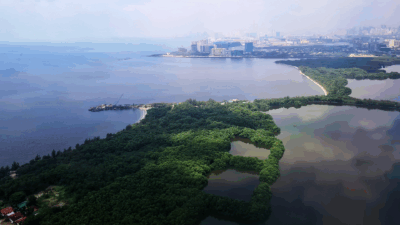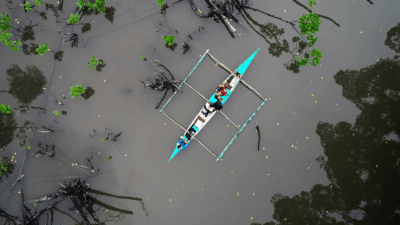July 9, 2025
Where the roots hold the shore: Mangrove biodiversity saves lives
Topics: Restore Mangrove Forests
In a country like the Philippines, with its more than 7,600 islands and over 36,000 kilometers of coastline, its coastal communities are highly vulnerable to the effects of climate change. The challenges from rising sea levels, strong typhoons, and more intense and erratic weather patterns become disastrous if mangrove forests that serve as the coastal communities’ first and last line of defense are destroyed.
More than just trees
At first glance, a mangrove forest might appear like a muddy, tangled mess. But beneath this intricate network of roots lies a rich tapestry of biodiversity. Mangroves provide nurseries for fish, crustaceans, and mollusks, while birds find food and refuge in these trees.
Even vulnerable species like the Philippine Duck rely on healthy mangrove wetlands to feed, nest and thrive. It’s not just wildlife that benefits from mangroves. Millions of Filipinos, especially small-scale fisherfolk, rely on the productivity of nearby coastal waters.
“In protecting our mangrove forest, the mangroves protected us back.”
Mangroves serve as natural barriers against typhoons and storm surges—forces that are intensifying due to climate change. Del Carmen, Surigao del Norte Mayor Alfred Coro II explained how mangroves saved their town when super typhoon Odette (Rai) and the COVID pandemic hit them in 2021. Their decade-long efforts of rehabilitating and preserving their mangrove ecosystems prepared them for a four-hour super storm. They had minimal loss of lives and property and gained a strong sense of hope and inspiration to be resilient. When food supply was threatened because of preventive quarantine protocols during the pandemic, their mangrove forest provided them with a stable food source.
A study by Wetlands International found that a100-meter belt of dense mangroves can reduce wave height by up to 66% and significantly slow storm surge currents. For a country that faces an average of 20 typhoons each year, this buffering effect is nothing short of lifesaving.
Additionally, mangroves serve as major carbon sinks, efficiently sequestering up to four times more carbon per hectare than terrestrial forests. These ecosystems are one of our most effective nature-based solutions to global warming.

In urban regions like Metro Manila, the remaining mangroves play a crucial role in reducing the risk of inland flooding. The Las Piñas–Parañaque Wetland Park (LPPWP), Metro Manila’s last remaining mangrove forest, is legally designated as a critical habitat. It helps protect nearby areas against flooding and poor water quality by filtering sediments and heavy metals from Manila Bay. However, despite its protected status, the LPPWP faces threats of extinction due to ill-planned reclamation projects, reflecting a troubling national trend.
Dwindling mangrove cover
Decades ago, unregulated conversion of mangroves into fishponds for aquaculture paved the way for the massive loss. In regions like Palawan and Northern Samar, where marine biodiversity is particularly rich, large-scale clearing of mangroves has disrupted natural habitats and reduced the productivity of coastal waters that local fishing communities depend on. Extensive dumping and filling of coastal cities such as Metro Manila, Cebu and other parts of the country aggravated the already dire state of mangrove forests.
From over 500,000 hectares in the Philippines at the beginning of the 20th century to approximately 300,000 hectares currently, the alarmingly rapid decline must be urgently addressed. The often prioritization of infrastructure over environmental sustainability has disastrous consequences. The decimation of mangroves that serve as natural barriers against storm surges and flooding while also providing essential services like water filtration and shoreline stabilization has grave consequences.
A law for the people and the planet

Oceana and other environmental groups are advocating for the swift passage of the National Coastal Greenbelt Act, a landmark legislation aimed at restoring and protecting mangrove and beach forests as natural buffers against disasters and the impacts of climate change. This proposed law seeks to institutionalize science-based coastal greenbelt zones in coastal towns and cities. It mandates the restoration, strict protection, and rehabilitation of degraded mangrove areas while prioritizing community involvement and ecosystem-based planning. If passed, the law will provide the legal framework and funding necessary for a nationwide effort to restore mangroves where they once thrived—and ensure they never disappear again.
Wavemakers, the time to act is now
Oceana believes that every Filipino has a role to play in restoring and protecting mangrove ecosystems. From lawmakers to local leaders, fisherfolk to the youth, civil society and academe, , the message is clear: we must act now.

The bill should be included in the priority bills of the administration of President Ferdinand Marcos Jr. and should be certified as an urgent measure.
Scan the QR Code or click this link: https://tinyurl.com/DearMrPresident-v2
Speak up on social media, share stories of successful mangrove rehabilitation in your communities, and hold accountable those responsible for our natural resources. Saving mangroves isn’t about trees; it’s about saving homes, livelihoods, and our future.
As climate threats intensify, we need proven, cost-effective, and community-driven solutions. Mangrove biodiversity offers all that – and so much more.
Let’s protect what protects us. (END)
